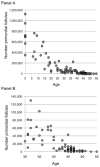Do women stop early? Similarities in fertility decline in humans and chimpanzees
- PMID: 20738274
- PMCID: PMC4043631
- DOI: 10.1111/j.1749-6632.2010.05527.x
Do women stop early? Similarities in fertility decline in humans and chimpanzees
Abstract
Two kinds of evidence suggest that female fertility may end at an earlier age in modern people than in ancestral populations or in our closest living relatives, chimpanzees. We investigate both to see whether fertility schedules or ovarian follicle counts falsify the alternative hypothesis that the age of terminal fertility changed little in the human lineage while greater longevity evolved due to grandmother effects. We use 19th century Utah women to represent non-contracepting humans, and compare their fertility by age with published records for wild chimpanzees. Then we revisit published counts of ovarian follicular stocks in both species. Results show wide individual variation in age at last birth and oocyte stocks in both humans and chimpanzees. This heterogeneity, combined with interspecific differences in adult mortality, has large and opposing effects on fertility schedules. Neither realized fertility nor rates of follicular atresia stand as evidence against the hypothesis that ages at last birth changed little while greater longevity evolved in our lineage.
Conflict of interest statement
The authors declare no conflicts of interest.
Figures







References
-
- Williams GC. Pleiotropy, natural selection, and the evolution of senescence. Evolution. 1957;11:398–411.
-
- Robson SL, van Schaik CP, Hawkes K. The derived features of human life history. In: Hawkes K, Paine RR, editors. The Evolution of Human Life History. School of American Research Press; Santa Fe: 2006. pp. 17–45.
-
- Oeppen J, Vaupel J. Broken limits to life expectancy? Science. 2002;296:1029–1031. - PubMed
-
- Howell N. Demography of the Dobe !Kung. Academic Press; New York: 1979.
-
- Hill K, Hurtado AM. Ache Life History: the Ecology and Demography of a Foraging People. Aldine de Gruyter; New York: 1996.
Publication types
MeSH terms
Grants and funding
LinkOut - more resources
Full Text Sources

